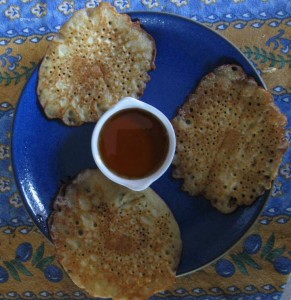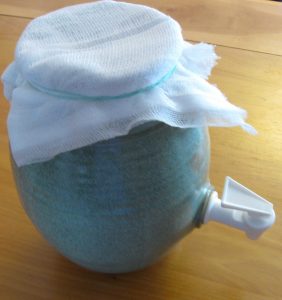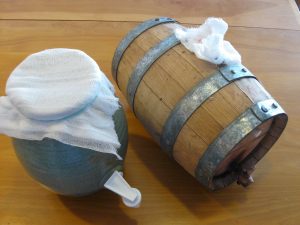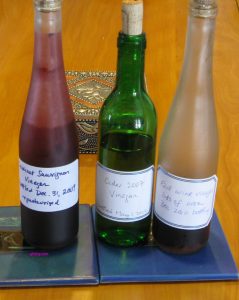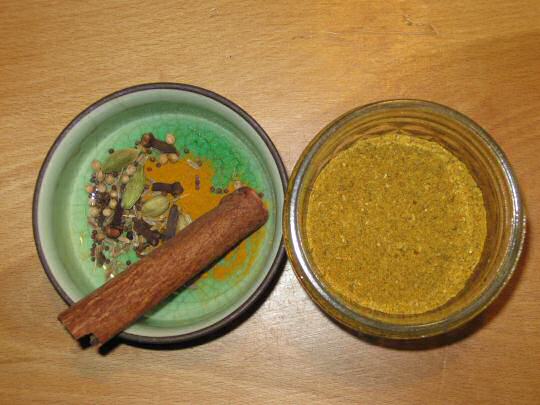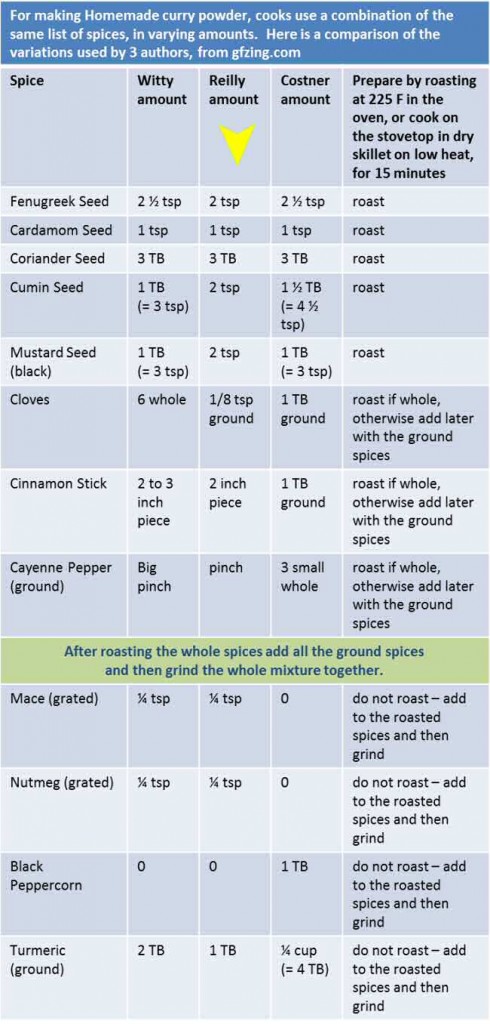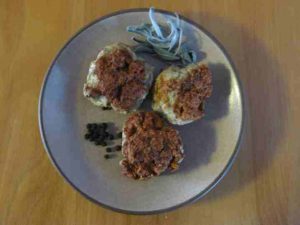By Alice DeLuca
A story for carnivores

This whole adventure started with a search for the perfect sausage to use in a recipe for pork with clams, which led to a little ceramic pig, and ended up with a truly excellent party. This cute little piece of specialty cookware, which looks like footwear for some impossible outer-space monster, is in fact designed for brazing sausages over flaming, hi-octane Portuguese liquor. As we learned the purpose and the method for using this device, we became completely distracted from our original mission and found ourselves planning a sausage-roast.
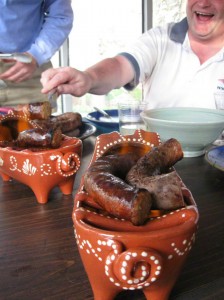
First, we had to obtain the little pig dishes from Portugal – that was easy and took only a few weeks. As soon as the dishes arrived we set about making home-smoked sausages and invited some guests to come over and roast them with us – RSVPs were instantaneous and none declined the invitation.
The sausages that are required – linguiça or chourico – are not easily found freshly made in the grocery store; the smoked sausages you do find are often laminated in plastic, oozing a creepy slime when opened, delivering a texture of rubber bands with what seem like bits of potato thrown in – the bits are the fat but for some reason completely unlike the fat in a homemade sausage. If these laminated sausages are the only smoked sausage you have ever known, then you must find some real, home-smoked sausages, or make your own. With pork shoulder and a few other ingredients, a good old-fashioned meat grinder, and some type of smoker, you can have a plate of these sausages to set fire to with your friends.

People have been making sausages and brazing them since the dawn of time. You can follow the accurate but brief instructions provided in the Ancient Roman De Re Coquinaria of Apicius (published by Walter M. Hill, 1936). Here, the proper color of smoked sausages is described perfectly – vermillion – a nearly forgotten word and color that deserves to make a comeback. Vermillion is the color of notoriously poisonous cinnabar, which is a substance with an interesting history of its own. Take a look at cinnabar on dolomite and you will see that the Romans have described the color of smoked sausage precisely in the recipe for Cirellos isiciatos, Round Sausage.
“Fill the casings with the best material [forcemeat]. Shape the sausage in to small circles, smoke. When they have taken on vermillion color, fry them lightly.”
The Recipe
To make linguiça, we chose “the best material” – a simple formulation with garlic, paprika and sweet rosé wine because pork is so often excellent with sweet, fruity flavors. Sausages of this type sometimes include oregano and vinegar, but this recipe “LINGUICA PORTUGUESA A’LA ANA“ is more delicious than those, perhaps because of the sweet rosé. The sausage ingredients are posted here with permission from AnaCatarina Louro Ferreira Alves, who generously provides the recipe to the world on her blog: http://anydaysoiree.com/
5 lbs. ground pork butt
3 Tb. paprika (not smoked)
2 Tb. fine minced garlic
3 Tb. salt
1 cup sweet rosé wine
1 tsp. sugar
1 Tb. black pepper
A sliced lemon for soaking the hog casings
Apple wood for smoking
Hog Casings – for stuffing – about 2 or 3 feet of casing per pound of meat
Concerning the Meat and its Preparation
Start out a day or two before you want to eat the sausage, to complete the marinating phase.
In an agrarian economy, the seasonal time for making sausage was in the fall when a hog was slaughtered; everyone hurrying to preserve the large quantities of meat for the long winter. Smoked sausage was a hedge against starvation. In the modern, refrigerated world, sausage can be made year-round and is a reason for a party! When making sausage at home, be careful to use safe food-handling techniques, clean equipment and clean hands at all times. Note that the Latin root of the word “botulism” is the word for sausage – botulus. That is not a coincidence. Study the conditions under which food pathogens can replicate and then avoid those conditions.
To obtain several pounds of ground pork for sausage, purchase a “pork shoulder” weighing over 9 pounds. Very carefully remove the skin from the pork shoulder (not used in the sausage), slice the meat from the bone with a boning knife, and cut the meat in to large chunks. The foundation of the pork shoulder is a complex articulated joint, so extreme care must be exercised when wielding the boning knife. How do orthopedic surgeons ever actually manage a functioning joint replacement?
Save the bone to cook with dried beans.
After cutting the meat from the bone, modern cooks might be tempted to eliminate and discard all the fat, but the fat and connective tissue are the keys to great flavor. Remove the fat and you surely will create disappointing, dry sausage like the last bit of an overcooked turkey breast that’s been loitering on the platter way too long after the Thanksgiving dinner. To make a good sausage, fat is required.
Marinating
Weigh the boned meat and season it with proportional amounts of the paprika, fresh garlic, salt, Portuguese rosé wine, sugar and pepper called for in the recipe. We had 6 pounds of meat, so we increased the seasonings proportionally.
Stir together the spices and wine, then mix in the chunks of meat – and commune with the ancestors who were marinating meat for millennia. Judging from 18th century engravings, the ancestors seemed to have had cats, chickens and dogs running around under the table during the sausage-making process, not the ideal situation for food preparation. Perhaps it is wise to banish the cats, dogs and chickens to the yard, before proceeding.
Unlike ancient peoples, we refrigerate the marinating meat and keep it cold during the remainder of the 1-2 day process.
Grinding
After marinating the meat under refrigeration, grind or chop it in to small pieces. There are many different types of grinding devices available. Whichever method you use, your goal is to produce small bits but not a paste – one of the principle differences between a sausage and a lowly hot dog is the consistency.
The mechanism of the old-fashioned meat grinder is an Archimedes screw. Archimedes of Syracuse, c. 287 BC – c. 212 BC, is credited with the invention of the screw conveyor which has been used since antiquity to move water uphill from one place to another. In a meat grinder, the screw is carrying the meat from one place to another (from the hopper to the blade.)
We use a Magimix food processor for chopping meat, working with a small amount of the meat at a time (maybe a half pound) and using the “pulse” feature – intermittent chopping – as noted in the directions that came with the machine. This works very well. Many older-model food processors would grind the meat too finely.
If you have an old fashioned meat grinder, use the blade and the coarsest disk. Again, a great opportunity for living the life of the ancestors presents itself. The sinews can clog up the disk, requiring frequent cleaning, We use our old-fashioned grinder mostly for stuffing the sausage casings. The grinder clamps to the table and can be easily removed, cleaned and stored.
Another style of meat grinder is screwed permanently to the table. We can’t see how this would be practical unless you grind things every day or perhaps enjoy the aesthetic and conversation-piece value of the thing – “Let us show you our newly renovated kitchen with built-in meat grinder….”
The other meat grinder that makes no sense is the kind that suctions to a smooth surface. This seems impractical because of the amount of force required to grind meat, and because suction devices usually cease to function correctly despite being adhered to a glass-smooth surface. How many times has the suctioned soap dish fallen in the shower, or the GPS device toppled in to the automobile?
One way or another, chop the marinated meat in to small bits, then chill it while you prepare the casings.
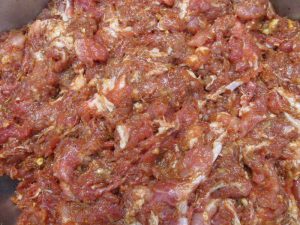
Preparing the Casings
The next step will be preparation of the hog casings. For unknown reasons, hog casings, if you are lucky enough to find any, are usually on the top right hand corner of the supermarket shelf that houses ham and pork products. In a plastic tub or sometimes a plastic bag, the “casings,” which are really cleaned intestines, are packed in salt. Years ago, hog casings had a distinctive funky odor but recently purchased hog casings have had no odor whatsoever. We were surprised to find that packages of hog casings come from all over the world – it is interesting to read the label on the package.
Soak the hog casings (3 feet for every pound of meat) in warm water with a sliced lemon for 30 minutes to soften and desalinate the casings, then run water through them to ensure they are clean (discard the lemon slices).
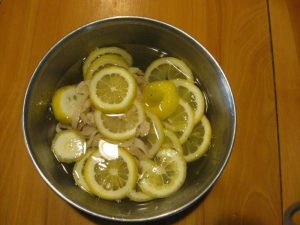
As the water runs through, marvel at the structure and strength of this wonderful material.
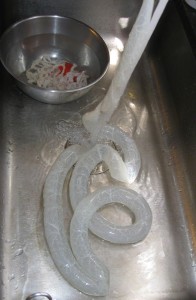
One of the many remarkable things about sausage casings, or intestines in general, is how terrifically strong they are. They have been used for millennia as string and thread, and as strings for musical instruments. The 120 foot intestine of a cow is formed in to harp strings and then, under enormous tension the strings are plucked to produce musical notes; Gut is used by surgeons to sew up wounds, and by tennis players to string their rackets so they can slam balls in to the ground at upwards of 70 mph.
Stuffing

It is much easier and more fun to stuff sausage with two people working than all by yourself.
Use a meat grinder to stuff the sausages. You need 3 feet of hog casing per pound of sausage, allowing for a little extra at each end of the sausage. Remove the blade and grinder disk and attach a sausage stuffing funnel. Slide a length of hog casing on to the funnel. Now put the seasoned sausage meat through the grinder, turning the handle slowly and steadily with one hand and easing the meat in to the casings with your other hand. The meat goes in to the hopper and comes out in to the casing. When the casing is nearly full (with 6 inches of empty casing remaining) remove the sausage from the funnel and start on the next sausage. Don’t complicate your life by trying to tie knots in this sausage. Just set the filled sausages aside to chill in the refrigerator until it is time to smoke them.

Smoking
Part of the reward for making your own smoked sausage is aromatic. The scent of smoked sausage would tame the wild wolf and bring him to your doorstep; it would make the wolf volunteer to be the captive family dog if only he could have some of this delicious meat.[i] (As expected, both our tame dog and cat became increasingly animated while the sausage was smoking, and eventually they were invited to retire indoors.)
Follow the instructions on a smoker, and use apple wood for the smoke. Check the internal temperature of the smoker to insure that it is hot enough to do the job safely. We used a Primo ceramic grill to smoke the sausage, paying careful and regular attention to adjusting the vents, and maintaining a higher temperature than recommended in the original recipe – just below 200° F. We chose to smoke the sausage until the internal temperature of the sausage was 170° F, which took approximately 3 hours. We recommend that any home cook do their own research to determine a safe process. The FDA provides some guidance on this. When completely smoked, the color of the sausages will be a deep red vermillion. The sausages are not preserved by this smoking – they are merely cooked through. From this point on, they should be preserved like any other meat – in cold storage for a few days or in the freezer for a longer period of time.
Do the homemade sausages look dry to you? That is the miraculous thing about real smoked sausage – although the exterior of the sausage is dry, the interior is just right – juicy and delicious. As a reward for your labor, taste a few slices before you put them away to chill.
Setting Things on Fire
Roasting sausages over flaming cheap brandy is a social form of cooking, an adventure to be shared with brave and hearty friends who enjoy hazardous adventure and are willing to take responsibility for their own actions. Perhaps you could have your guests agree to a “Safe Sausage Disclaimer”:
“I recognize that consuming homemade sausage is fraught with danger and I am willing to fully assume all the risk and untold horrors so I may experience real food.”
We used a little parade of two “assadors” to roast our sausages. For fuel, we used inexpensive aguardente, lighting the flame under the sausages with foot-long matches and keeping a fire extinguisher available nearby. (Incidentally, we are intrigued to learn more about the high-walled linguiceira shown at the Borderless Cooking blog. It appears immune to the windy conditions that prevailed during our party.)
Place the assador on a heat-proof surface, preferably in a location that is not windy. Pour a pool of aguardente in to the assador. Using a long match, set the aguardente ablaze without setting anything else on fire. Cut off pieces of sausage to fit the assador and place them on the racks over the flames. As the sausage cooks, some of the fat melts in to the cooking device and fuels the alcohol-based fire, and as this happens the flame goes from blue to yellow and the sound of sizzling fills the air. The blue flame from burning alcohol is cooler than the ensuing yellow flame from the burning fat. The cooking process speeds up as the flame turns yellow and gets hotter. Turn the sausages carefully with tongs, and make sure to cook them until they are blackened. Remove them from the flames too soon and the interior will be dry and hard. Keep cooking the smoked sausages until they are crisped up on the outside, and the fat is melting on the inside. One of our assadors acquired a small crack during the roasting party, so again, take precautions and take good care.
Video:
Linguica roasting over aguardente
We poured a rosé with the linguiça, to match the flavoring component of the sausage. A dry, hard cider and beer were also fine accompaniments, along with a Colombian bean dish, a selection of cheeses including the outstanding Winnimere cheese from Jasper Hill Farm in Vermont, and a fine green salad supplied by some excellent cooks among the company at the table. We ate, as the Hawaiians say, until we were tired.
Notes for further study: There are other versions of this type of sausage brazing grill – This one uses skewers, for example. This one shows a much deeper, sturdier cooker which we are interested in acquiring, in case anyone knows where to get one. Here is a video recipe that shows grilled linguiça as a garnish for a small soup.
[i] Read: The Cat That Walked by Himself, by Rudyard Kipling: http://www.gutenberg.org/files/2781/2781-h/2781-h.htm#2H_4_0011

